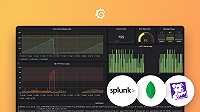DynamoDB data source for Grafana
The DynamoDB data source allows a direct connection to DynamoDB to query and visualize DynamoDB data in Grafana.
This data source supports PartiQL and provides an editor to format and color code your PartiQL statements.
DynamoDB plugin is available for the following account types:
- Users with a Grafana Cloud Free, Advanced or Trial account or with an activated Grafana Enterprise license.
Installation
For detailed instructions on how to install the plugin on Grafana Cloud or locally, please checkout the Plugin installation docs.
Manual configuration
Once the plugin is installed on your Grafana instance, follow these instructions to add a new DynamoDB data source, and enter configuration options.
Configuration options
The DynamoDB Data Source uses the AWS SDK for Go to connect to your DB cluster with AWS IAM Credentials. There are a few possible ways to configure your data source instance with Grafana to specify how you’d like to connect with AWS:
Configure data source with a provision file
It is possible to configure data sources using configuration files with Grafana’s provisioning system. To read about how it works, including all the settings that you can set for this data source, refer to Provisioning Grafana data sources.
Here are some provisioning examples for this data source using basic authentication:
apiVersion: 1
datasources:
- name: DynamoDB
type: grafana-dynamodb-datasource
jsonData:
authType: keys
endpoint: local/remote endpoint
defaultRegion: us-west-2
migrated: true
secureJsonData:
accessKey: <YOUR ACCESS KEY>
secretKey: <YOUR SECRET KEY>or for ~.aws/credentials
apiVersion: 1
datasources:
- name: DynamoDB
type: grafana-dynamodb-datasource
jsonData:
authType: credentials
endpoint: local/remote endpoint
profile: <YOUR PROFILE>
defaultRegion: us-west-2
migrated: true
secureJsonData:Time series
Time series visualization options are selectable after adding a datetime
field type to your query. This field will be used as the timestamp. You can
select time series visualizations using the visualization options. Grafana
interprets timestamp rows without explicit time zone as UTC. Any column except
time is treated as a value column.
Multi-line time series
To create multi-line time series, the query must return at least 3 fields in the following order:
- Field 1:
datetimefield with an alias oftime - Field 2: value to group by
- Field 3+: the metric values
For example:
SELECT log_time AS time, machine_group, avg(disk_free) AS avg_disk_free
FROM mgbench.logs1
GROUP BY machine_group, log_time
ORDER BY log_timeTemplates and variables
To add a new DynamoDB query variable, refer to Add a query variable.
After creating a variable, you can use it in your DynamoDB queries by using Variable syntax. For more information about variables, refer to Templates and variables.
Known limitations
Currently querying data from nested maps is not supported and will return null value.
Learn more
- Add Annotations.
- Configure and use Templates and variables.
- Add Transformations.
- Set up alerting; refer to Alerts overview.




